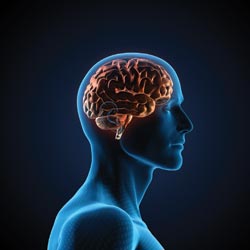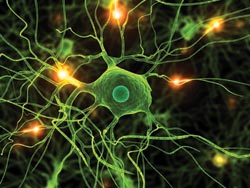Their goal is to understand the epileptic brain. And the key just might be fluorescence lifetime imaging microscopy – also known as FLIM.
Michael J. Levene, assistant professor of biomedical engineering at Yale University in New Haven, Conn., and a resident fellow at Yale’s Jonathan Edwards College, has assembled a team to investigate neurometabolism in brain tissue from patients with epilepsy.
The disorder, according to the Epilepsy Foundation, is a medical condition producing seizures – brief but strong electrical surges in the brain – which affect various mental and physical functions. Symptoms range from convulsions and loss of consciousness to blank staring, lip smacking or jerking movements of the legs and arms. The foundation says that one in 10 adults will experience a seizure at some point.
Neurometabolism and epilepsy
“Brain metabolism, even in a nondiseased state, is not fully understood,” said Thomas H. Chia, a fourth-year doctoral student in the biomedical engineering department at Yale and a member of Levene’s team. “As a result, trying to dissect the exact cause and mechanism behind neurometabolism abnormalities in epileptic tissue is even more difficult.”
 Brain regions where seizures start, Levene explained, have slower metabolism than normal brain tissue. “This might seem somewhat paradoxical, since these regions are clearly hyperactive during seizures.”
Brain regions where seizures start, Levene explained, have slower metabolism than normal brain tissue. “This might seem somewhat paradoxical, since these regions are clearly hyperactive during seizures.”
The underlying cause of this slower metabolism – as well as its relation to epilepsy – is still unclear, Levene said. Some researchers blame it on the large loss of neurons that can occur when epilepsy develops. “However, there is also a large increase in the number of reactive [or abnormal] astrocytes, so the total number of cells of all types in the region may not decrease significantly.”
An alternative hypothesis to neuron loss, according to Levene, involves mitochondrial dysfunction in the astrocytes, which are glial cells responsible for clearing the excitatory neurotransmitter glutamate from the synaptic cleft. If the glutamate is not cleared away properly, overstimulation of the postsynaptic neuron could occur, possibly initiating a seizure.
“Under this hypothesis,” he said, “the impaired mitochondria result is in sufficient clearing of glutamate, and thereby the hypometabolism may be a cause, rather than just an effect, of epilepsy.”
“If astrocytes begin to behave differently or proliferate,” Chia said, “it can have drastic effects on the stability of neurons and lead to recurrent seizures.”
Getting excited with FLIM
Fluorescence imaging depends on exciting a material that emits fluorescence – a fluorophore – and then allowing it to relax and release a photon. “Fluorescence lifetime” refers to the length of time during which the fluorophore is in an excited state.
“As the lifetime of a fluorophore increases, its effective ‘brightness’ increases as well,” Chia said. He explained that fluorescence lifetime is usually measured in nanoseconds and that the lifetime of a given fluorophore can be affected by differences in pH, local viscosity, temperature and enzymatic binding. “FLIM looks to add a spatial component to lifetime measurements by producing an image where each pixel represents the lifetime of fluorophores in that particular volume of the sample.”
Using a two-photon scanning laser microscope, the team images tissue from epileptic brains on the cellular level, hoping to discover specific metabolic defects in the tissue.
 The investigators use time-correlated single-photon counting (TCSPC) to perform FLIM: Pulses of about 100 fs from a Ti:sapphire laser excite fluorescence, which is collected by a multichannel plate photomultiplier tube with a quick response time. The photomultipler tube then sends a transistor-transistor logic pulse to a TCSPC computer card, which, in turn, records the time needed for the very first photon received from the tube. Photons that arrive after that first photon are ignored until the next laser pulse is sent.
The investigators use time-correlated single-photon counting (TCSPC) to perform FLIM: Pulses of about 100 fs from a Ti:sapphire laser excite fluorescence, which is collected by a multichannel plate photomultiplier tube with a quick response time. The photomultipler tube then sends a transistor-transistor logic pulse to a TCSPC computer card, which, in turn, records the time needed for the very first photon received from the tube. Photons that arrive after that first photon are ignored until the next laser pulse is sent.
“A histogram of photon arrival times is then built up for each pixel, and this histogram can be fit to a multiexponential decay after deconvolution of the impulse response of the system,” Levene said.
A co-enzyme and endogenous fluorophore called NADH (nicotinamide adenine dinucleotide plus hydrogen is the focus of the team’s research.
Chia said that NADH is vital to the energy production pathways inside cells and that it loses its fluorescence when it oxidizes to NAD+. Because of this, Levene said, “we can use NADH fluorescence as a proxy for the metabolic state both in mitochondria, where oxidative metabolism takes place, and in the cytosol, where nonoxidative metabolism takes place.”
Chia said that, when measured in a complex environment such as the brain, NADH will have multiple fluorescence lifetimes. “FLIM can help us discern different enzymatic binding by the NADH found in epileptic brain tissue. By doing so, we can see where NADH is concentrated and what type of enzymatic activity it is undergoing.”
With this information, the researchers hope to piece together a model of neurometabolism in the epileptic brain.
FLIM and epilepsy
The task for Levene’s team is to figure out which cells – neurons or astrocytes – and which cell parts – mitrochondria or the cytosol – participate in NADH’s response to stimulation, both in epileptic tissue and in control samples. “And to characterize both the concentration change and changes to binding of NADH in these regions,” Levene added.
Chia said that NADH, when “free” or unbound to an enzyme, has a distribution of lifetimes ranging from about 200 to about 400 ps. Binding to one particular enzyme changes the lifetime of NADH to a difference distribution of approximately 500 to about 700 ps. Binding to another enzyme gives NADH a lifetime distribution of about 4 to 5 ns.
Assigning a unique color to each of the three “species” of NADH – short-, medium- and long-lifetime – gave the researchers an image of where NADH is free, bound to an enzyme giving a medium lifetime, or bound to an enzyme giving NADH a very long lifetime.
“As it turns out,” Chia said, “free NADH is predominantly located in the cytosol; NADH bound to an enzyme giving it a medium lifetime is predominantly found in the neuropil; and NADH bound to an enzyme giving it a long lifetime is predominantly found inside the mitochondria.
“These data are convincing, given that the cytosol has relatively low metabolic activity compared to the neuropil, where all the synaptic communication occurs. It is not surprising that mitochondria have longest-lifetime NADH because of the high metabolic activity that occurs inside this organelle.”
Applying this custom program to data from rats with a model for temporal lobe epilepsy (pilocarpine model) as well as to a group of wild-type control mice resulted in initial data that shows oxidative-metabolism defects in the dendritic layer of the pilocarpine model rat.
“Additionally, there may be abnormalities that are preventing an increase in NADH in the cell layer,” Chia said. “This could be due to increased oxidation in cytosol – more NADH changing over to NAD+ – or deficiencies in NAD+ reduction.”
Future research
Even with the initial success of their image-processing approach, there is still much to be done, and Levene has received funding from the Dana Foundation for the continuation of the studies.
“The next step,” Chia said, “is to apply our technique to more tissue samples. We plan to complete a more comprehensive study using an animal model of temporal lobe epilepsy and compare the data to wild-type animals of the same strain.”
But animals aren’t the only subjects: By teaming up with Yale’s department of neurosurgery, Levene has gained access to living human brain tissue removed from epileptic patients.
“The ultimate goal is to pinpoint exact abnormalities in epileptic brain tissue and develop therapy to restore the tissue to its original neurometabolic state,” Chia said.